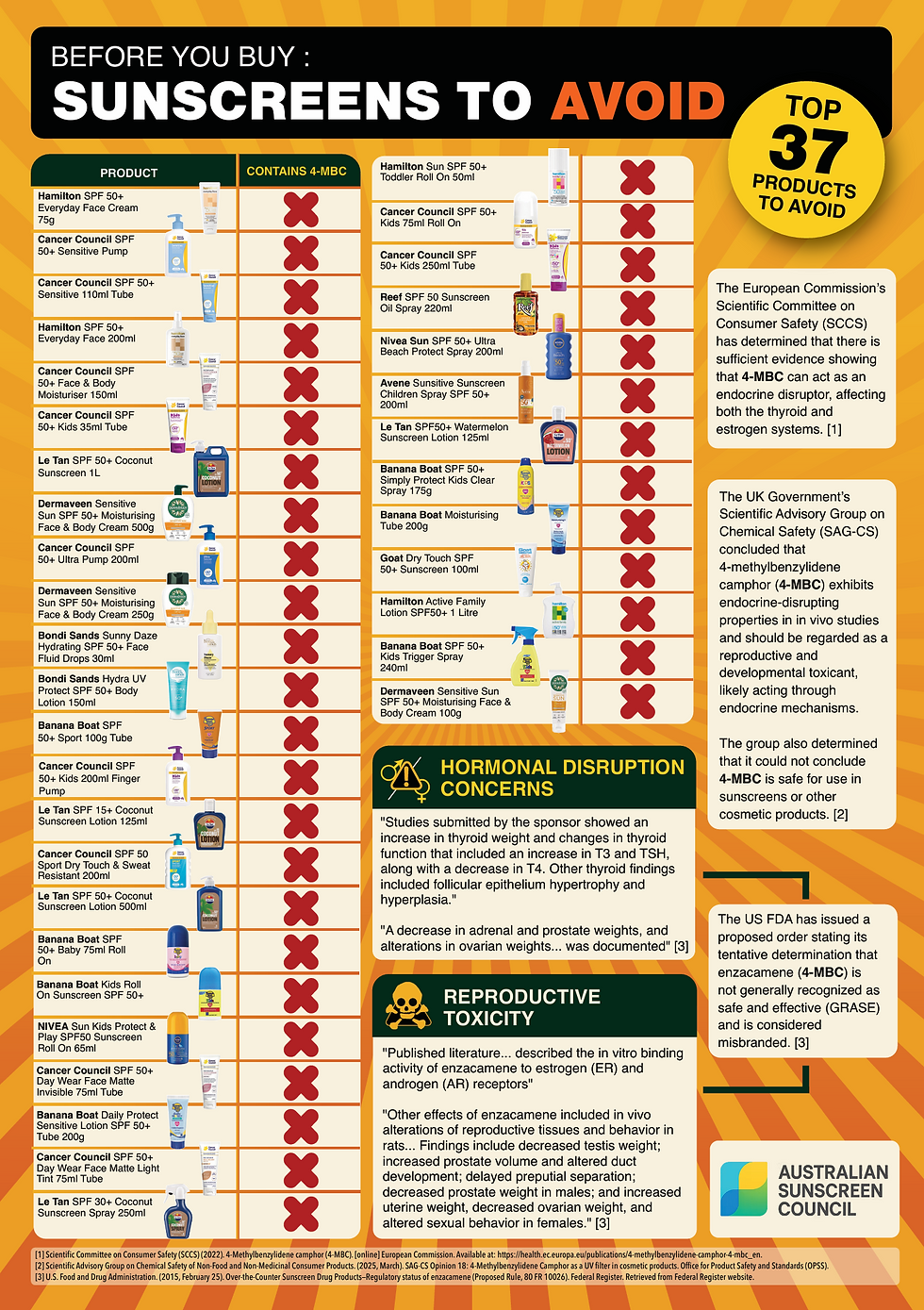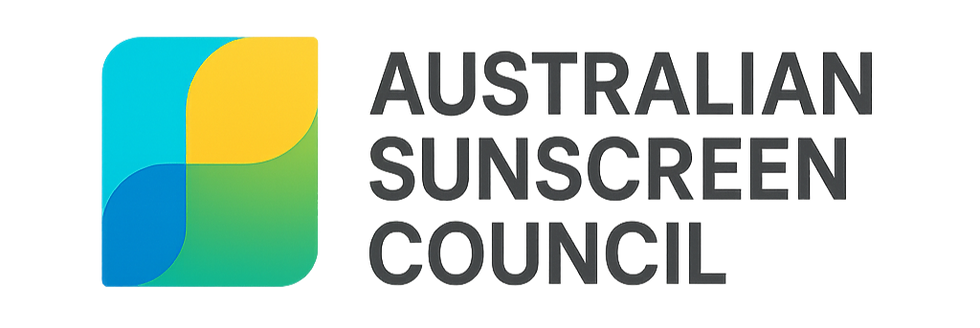A Public Health Imperative: An Analysis of 4-Methylbenzylidene Camphor (4-MBC) in Australian Sunscreens
- Dr Yousuf Mohammed

- Aug 25
- 6 min read
By Dr. Yousuf Mohammed
A Confluence of Global Regulatory Concern:
Dr. Mohammed provides the following analysis, grounded in the official published findings of the world's most respected regulatory agencies.
"When multiple, independent, expert-led international bodies arrive at the same conclusion, it signals a clear scientific consensus. The case of 4-MBC is no longer a matter of debate; it is a matter of regulatory action. The data from the EU, UK, and USA collectively paint a picture of a substance with an unacceptable risk profile for widespread consumer use. Australia's current position is now in direct conflict with the weight of this global evidence."
The Official Evidence Against 4-MBC
The European Union’s Prohibition (Regulation (EU) 2024/996)
The European Commission's Scientific Committee on Consumer Safety (SCCS) has performed the most recent and exhaustive review, leading to a complete ban of 4-MBC.
On Endocrine Disruption: The SCCS states there is "sufficient evidence that 4-MBC may act as an endocrine disruptor and has effects on both the thyroid and estrogen systems." [health.ec.europa.eu]
On Inability to Establish Safety: The core of the EU's decision rests on critical data gaps. The official EU Commission Regulation notes the SCCS concluded it "cannot determine a safe concentration limit for 4-MBC because the overall assessment of its potential for genotoxicity could not be completed." It further elaborates, "In view of the serious concerns raised with regard to potential endocrine-disrupting properties of 4-methylbenzylidene camphor, the Commission considers that that substance should be banned for use as a UV filter in cosmetic products." [eur-lex.europa.eu]
The United Kingdom's Aligned Conclusion (SAG-CS)
The UK's own Scientific Advisory Group on Chemical Safety (SAG-CS) conducted an independent review and arrived at a harmonised conclusion, reinforcing the SCCS findings.
On Reproductive Toxicity: The SAG-CS opinion is definitive, stating, "The Members agreed that 4-methylbenzylidene camphor (4-MBC) exhibits endocrine-disrupting properties in in-vivo studies and should be regarded as a reproductive and developmental toxicant, likely acting through endocrine mechanisms." [assets.publishing.service.gov.uk]
On Data Deficiencies: Echoing the SCCS, the UK committee highlighted, "There are concerns with regard to the safety of 4-MBC including the lack of a robust genotoxicity and reproductive/developmental toxicity package." This led to their final verdict: "The Committee was not able to derive a safe level for use of 4-MBC as a UV-filter in cosmetic products and therefore could not conclude that 4-MBC is safe for use in sunscreen products." [assets.publishing.service.gov.uk]
United States (FDA)
The U.S. Food and Drug Administration (FDA) has a different regulatory framework, but its conclusion on 4-MBC (enzacamene) is functionally the same: it is not permitted for use.
On Safety Recognition: The FDA has issued a proposed order stating its "tentative determination that enzacamene is not generally recognized as safe and effective (GRASE)." [https://www.federalregister.gov]
Implications of "Not GRASE": This status means that the ingredient lacks sufficient evidence to be considered safe for public use in an over-the-counter product such as sunscreen.
Regulatory Failure in Australia (TGA)
Rather than a harmless “divergence,” Australia’s Therapeutic Goods Administration (TGA) has failed to remove 4-MBC from listed sunscreens and is, effectively, asleep at the wheel—while Australian consumers and families bear the risk. The TGA still permits 4-MBC at 4% despite its prior assessment predating the most recent SCCS and SAG-CS opinions. The TGA’s own 2001 safety alert acknowledged early estrogenic signals—reporting an “increase in uterine weight in immature rats treated dermally with 4-MBC”—yet concluded that “the issues raised in the Schlumpf article do not appear to require action at the present time.”
Recent FOI releases [FOI 25-0104 and FOI 25-0146] show the agency collating evidence of human exposure—including detection of 4-MBC in human breast milk at 2.10–134.95 ng/g lipid, positively correlated with sunscreen use—and continuing to consider endocrine-disruption concerns (FOI 25-0146). In line with current toxicology, camphor-derivative UV filters are reported as capable of disrupting the hypothalamic–pituitary–gonadal (HPG) axis, and recent reviews summarise reproductive and developmental effects of 4-MBC. [https://www.tga.gov.au/]
There is no defensible basis for 4-MBC to remain approved in Australia. The Federal Health Minister, Mark Butler, should cease issuing the quarterly Ministerial determinations that keep 4-MBC on the permitted list.
Conclusion: Immediate Action to Protect Consumers
Sunscreen is a public-health necessity, but the actives used must be beyond reproach. Continuing to allow 4-MBC in Australian products is an avoidable risk that erodes public confidence. The Australian Sunscreen Council calls on the TGA to commence an urgent, formal re-review of 4-MBC’s safety and approval status and, pending that review, to withdraw its listing. We further call on the Federal Health Minister to stop using Ministerial determinations to preserve 4-MBC’s availability and to align Australia with international safety standards without delay.

Recommendations for Consumers and Clinicians
Immediate advisory: As at 25 August 2025, the TGA has presented no public evidence demonstrating that 4-MBC is safe for use in Australian sunscreens. Until robust, transparent safety data are produced, cessation and avoidance are warranted.
Consumer action (cease use & avoid):Consumers should stop using and avoid purchasing any sunscreen listing “4-Methylbenzylidene Camphor,” “4-MBC,” or “enzacamene.” This advice is especially critical for children, pregnant or breastfeeding people, and anyone with endocrine conditions. Choose alternatives with well-established safety profiles—zinc oxide formulations are recommended.
Clinical guidance:Dermatologists, GPs, and pharmacists should advise patients to discontinue products containing 4-MBC and substitute with safer alternatives (e.g., zinc oxide sunscreens). Document exposures where relevant and consider reporting suspected adverse effects through the TGA’s adverse event reporting pathway.
Regulatory re-evaluation (urgent):The Australian Sunscreen Council calls on the TGA to immediately suspend 4-MBC pending a formal, transparent re-review that accounts for the current international scientific record and overseas regulatory actions. The Federal Health Minister should cease issuing Ministerial determinations that keep 4-MBC on the permitted list in the absence of safety evidence.
For a more comprehensive list of sunscreens to avoid, we’ve published a CSV of 130 ARTG (Australian Register of Therapeutic Goods) sunscreen listings that declare 4-MBC / 4-methylbenzylidene camphor (query run 23 Aug 2025) as an active ingredient.
About Dr. Yousuf Mohammed
Dr. Yousuf Mohammed is Associate Professor at the University of Queensland School of Pharmacy and a global leader in topical and transdermal drug delivery research. He completed his PhD in pharmaceutics and skin drug delivery and has been working in the field of skin delivery at the Therapeutics Research Centre since 2012. Dr. Mohammed leads multiple U.S. FDA-funded projects as Principal Investigator, including the five-year "Bioequivalence of Topical Products: Elucidating the Thermodynamic and Functional Characteristics of Compositionally Different Topical Formulations" project that directly shapes regulatory guidelines for topical and semisolid products.
Official Regulatory Sources:
1. European Commission's Scientific Committee on Consumer Safety (SCCS)
SCCS Opinion on 4-MBC: https://health.ec.europa.eu/system/files/2023-08/sccs_o_262.pdf¹
EU Commission Regulation banning 4-MBC: https://eur-lex.europa.eu/legal-content/EN/TXT/PDF/?uri=OJ%3AL_202400996²
2. United Kingdom's Scientific Advisory Group on Chemical Safety (SAG-CS)
3. United States Food and Drug Administration (FDA)
U.S. Food and Drug Administration. "Over-the-Counter Sunscreen Drug Products-Regulatory Status of Enzacamene." Federal Register, Vol. 80, No. 37, February 25, 2015. Available at: https://www.federalregister.gov/documents/2015/02/25/2015-03884/over-the-counter-sunscreen-drug-products-regulatory-status-of-enzacamene⁴
Prefer a docket-stamped PDF for archiving? Use the Regulations.gov copy of FDA’s proposed order on enzacamene (Docket FDA-1978-N-0018-0775).
https://downloads.regulations.gov/FDA-1978-N-0018-0775/content.pdf
4. Australian Therapeutic Goods Administration (TGA)
TGA Safety Alert 2001: https://www.tga.gov.au/news/safety-alerts/sunscreens-potential-oestrogenicity-sunscreens
TGA FOI 25-0104: https://www.tga.gov.au/sites/default/files/2025-07/FOI%2025-0104.pdf
TGA FOI 25-0146: https://www.tga.gov.au/sites/default/files/2025-05/FOI%2025-0146.pdf⁵
Supporting Academic and Industry Sources:
5. Dr. Yousuf Mohammed's Profile and Research
University of Queensland Expert Profile: https://about.uq.edu.au/experts/11844⁶
6. Australian Sunscreen Council
ASC Safety Issues Page: https://www.australiansunscreencouncil.org/issues-sunscreen-safety-australia⁷
7. Additional Research Sources:
Environmental occurrence data: https://pmc.ncbi.nlm.nih.gov/articles/PMC3673939/⁸
Reproductive toxicity studies: https://onlinelibrary.wiley.com/doi/10.1111/bcpt.13901⁹
Endocrine disruption review: https://link.springer.com/10.1007/s40572-025-00492-9¹⁰

About the Australian Sunscreen Council
The Australian Sunscreen Council is the representative body for Australia's $500 million sunscreen industry. The Council is dedicated to championing the highest standards of sunscreen safety, efficacy, and ethical manufacturing. It unites manufacturers, clinicians, brand owners, and researchers to ensure that every sunscreen product sold in Australia is built on a foundation of integrity and trust. Through active collaboration with government, health professionals, and industry stakeholders, the Council advocates for robust, evidence-based regulations and works to advance Australia's global leadership in photoprotection and sun safety.




Comments